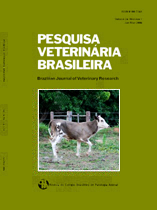 |
|
|
|
Year 2013 - Volume 33, Number 9
|

|
The importance of poisoning by Amorimia pubiflora (Malpighiaceae) in cattle in Mato Grosso: experimental reproduction of the poisoning in sheep and cattle, 33(9):1049-1056
|
ABSTRACT.- Becker M., Caldeira F.H.B., Carneiro F.M., Oliveira L.P., Tokarnia C.H., Riet-Correa F., Lee S.T. & Colodel E.M. 2013. [The importance of poisoning by Amorimia pubiflora (Malpighiaceae) in cattle in Mato Grosso: experimental reproduction of the poisoning in sheep and cattle.] Importância da intoxicação por Amorimia pubiflora (Malpighiaceae) em bovinos em Mato Grosso: reprodução experimental da intoxicação em ovinos e bovinos. Pesquisa Veterinária Brasileira 33(9):1049-1056. Departamento de Clínica Médica Veterinária, Faculdade de Agronomia, Medicina Veterinária e Zootecnia, Universidade Federal de Mato Grosso, Av. Fernando Corrêa da Costa 2367, Cuiabá, MT 78068-900, Brazil. Email: moleta@ufmt.br
In the county of Colniza, Mato Grosso, the main limitation for livestock production is the occurrence of “sudden death” in cattle, which affects in some farms up to 50% of the herd. In visits to some of the farms where the problem occurred, in 2004, 2011 and 2012, the presence of Amorimia pubiflora on the pastures was associated with the occurrence of “sudden deaths” in cattle. The deaths occurred throughout the year, however more frequently at beginning of the rainy season, when A. pubiflora sprouts in the grazing areas. The poisoning was experimentally reproduced in sheep and cattle by the administration of young leaves of the plant collected during two seasons, and in sheep by the administration of mature leaves and fruits. In the sheep that died, the first clinical signs were observed between 34min and 17h34min after the administration of the plant, and the clinical course varied from 3min to 15h20min, with a final peracute phase of 3 to 21 minutes. The main clinical signs were tachycardia, engorgement of the jugular veins, muscle trembling, apathy and reluctance to move, which were more evident when the animals were moved. The peracute final phase was characterized by generalized tremors and muscle contractions mainly of limbs, head and neck, respiratory distress and abdominal respiration, sternal and quick lateral recumbence or falling to the ground with peddling movements, opisthotonus, nystagmus, nystagmus and cyanosis of the oral mucosa, followed by death. The young leaves of A. pubiflora, independent of the collection period, were more toxic and caused death of sheep and cattle after ingestion of 2g/kg and 3g/kg respectively. Mature leaves caused death at the dose of 20g/kg, and the fruits at 5g/kg. The young leaves contained 0.015% of sodium monofluoracetate which is responsible for clinical signs of the “sudden death”. These findings show the importance of Amorimia pubiflora for cattle raising in Midwestern Brazil. The plant is toxic also for sheep causing a clinical picture similar to that reported in cattle poisoned by monofluoracetate-containing plants. |
| |
|
|
| |
|
 |